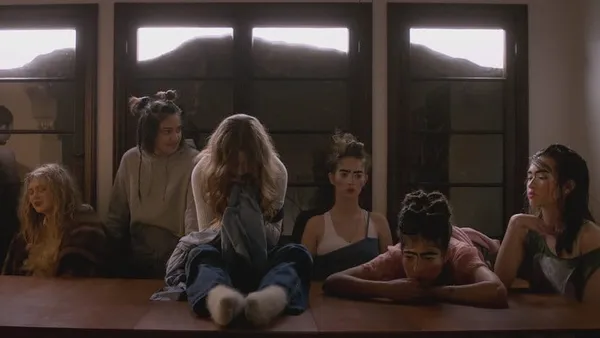Eye For Film >> Movies >> Ladyworld (2018) Film Review
Ladyworld
Reviewed by: Jennie Kermode

When the idea of a 'female Lord Of The Flies' was first mooted, there was a lot of speculation, both on the internet and in the popular press, about what that might mean. It had long been argued by some feminists and by conservatives that the story couldn't be told with female characters because girls would be sensible and cooperate and not give way to savage instincts as the boys in William Golding's classic novel did. Other feminists contended just as strongly that girls, being human, are equally capable of brutality. Which way would director Amanda Kramer jump?
Ladyworld opens with a blank, black screen and a staggering soundscape. Low rumbling sounds give way to creaking masonry, the heavy thud of objects falling - a disorientating experience for viewers which immediately pushes us out of our comfort zone. We first become aware of the girls through their screams. Later, when the lights come on, we meet Olivia (Ariela Barer) who is quickly joined by Dolly (Ryan Simpkins). As they try to make sense of the situation, other girls wander in. They were sleeping over after a birthday party. Now they're trapped underground. Was there an earthquake? Was there, someone suggests, a war? At first they assume their parents will come to rescue them but when that doesn't happen, panic starts to set in.
In fact, the notion that the girls are trapped isn't altogether convincing. There's an upper window pane in one of the rooms that looks as if it would be easy to break and, with a bit of digging, climb out through; there's even a table to stand on. It's not quite clear why Kramer has left this here, like a ship permanently cruising along the horizon. Is she saying that the girls are trapped as much by their fears as by their physical situation, or implying that there's a wilful element to their situation? Either way, it sits there in the background of many a shot, nagging at viewers, creating a sense of distrust.
In the initial stages, the film sticks closely to Golding's formula. A crystal from a fallen chandelier replaces the conch as an item the girls have to be holding to have the right to speak, but this kind of order doesn't last for long, and when order breaks down, there is a distinctly gendered aspect to the process. These are people who have never been instilled with the idea that disagreements should be resolved by force. Instead they resort to subtler forms of cruelty. The violence that eventually comes, emerges as the natural end result of a process of escalation. If there's a difference between boys and girls, Kramer seems to be saying, it's simply that boys lack the training to try other things first.
The violence in Lord Of The Flies, of course, stems partly from the boys' growing conviction that there is a beast somewhere on their island and they must protect themselves from it. Here the figure of the beast is represented by a man whom one of the girls insists she has seen in the basement. As Golding's protagonists' obsession with the beast seemed to make them ever more beastly themselves, so the girls' obsession with the potential threat represented by the man seems to lead them into more traditionally masculine patterns of behaviour. Even as they dress up in fabulous costumes, experiment with elaborate make-up (war paint?) and become increasingly flirtatious with each other, they are arming themselves, claiming territory and embarking on raids. This isn't the trained aggression of public schoolboys; this is something far more raw.
The contrast between that rawness and the girls' sophisticated affectations lies at the core of Kramer's film. It's present in the soundtrack, a deliberately intrusive melange of rumbling noises which recall the terror of the quake and female vocal sounds, sometimes ethereal, sometimes guttural, Ariel and Caliban (to borrow from another island) caught in the same throat. It's there in the camerawork that emphasises bright, open rooms yet leaves us hardly any room to move.
The trouble with all this is that Ladyworld becomes so burdened by art and symbolism that it almost loses sight of the need to tell a story. Kramer struggles with pacing and at points that soundtrack will make you want to scream for all the wrong reasons. The film is smart and artistically interesting but, in places, almost unwatchable. The actors try valiantly to overcome this. Barer's solidity in the lead is admirable and she does well to hold her own against Annalise Basso, who has fun with plum role of Piper (analogous to Golding's Jack). Dolly is the third player in the central trio - perhaps alert to the risks of having a female character bullied over her weight, Kramer instead makes her a misfit who carries a doll everywhere, but Simpkins, though capable, doesn't quite deliver the necessary complexity.
Where we move away from Golding's structure, the narrative work here is too thin to sustain the film's running time. Some repetition may be necessary to create that sense of timelessness in which people easily forget that they can be held accountable for their actions, but the balance is off. Ladyworld is an intriguing experiment that runs out of steam.
Reviewed on: 30 Jul 2019


















